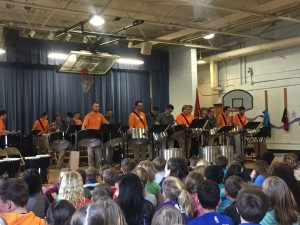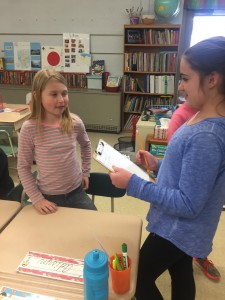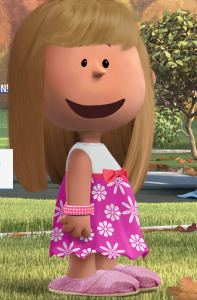My Spring Break Trip
My spring break trip was very fun and exciting. On spring break my family and I went to Cancun Mexico we stayed at a resort called Omni Cancun Hotel and Resort. While we were in Mexico we went to the two pools, hot-tub, and ocean a lot. The pools were really fun because they were like infinity pool. The ocean had a lot of big waves that you can body surf on. In Mexico I got a big sunburn it is kinda going away and becoming more tan than red. We also ate at a really cool restaurant called Da Vinci’s . The restaurant was based on Leonardo DaVinci so there were a lot of paintings and art by him. In summary these are the reasons why my family and I had such a great spring break trip to Mexico.
My Awesome Week 27
My week 27 was pretty awesome. The reason my Friday post is a week late is because I was not at school last Friday because I left for Mexico (spring break) early that morning. So one of the first things we did was plant our class garden. It was so fun to plant the garden because we planted a lot of different types of beans and radishes. We also got a lot more microphones and this recording thing that takes out any loud breaths you make while singing. One of the last things we did was write some of our research papers my topic is Hawaiian culture. In summary this is how my week was so awesome.
My Great Week 26
My week 26 was pretty good. One of the first things we had to do was TN-Ready it was not that fun. We had to test Wednesday,Thursday,and Friday and then we have to test on Monday. On Tuesday we had no school because it was election day. We also got our letters back from India then we wrote back to them. One of the last things we did was have double recess on Thursday while we were outside it started to snow. In conclusion this is how my week 26 was pretty great. 
Haney Court
Uniforms in School from Jordan Haney on Vimeo.
Week 25 Was Awesome

My week 25 was awesome. One of the first things we did was have Dads and Donuts. Dads and Donuts is where you come to school a little early and you get have a donut with your dad. We also finished our Haney Court it was so fun. The Steel Drum UT Band came to our school and played a couple of songs for us it was very cool. One of the last things we did was have an event at Wendy’s where if you ate at Wendy’s part of the money you paid was sent to school. In summary this was why my week 25 was pretty cool.
My Awesome Week 24
My week 24 was awesome.The reason I don’t have a week 23 blog is because we had a couple of snow days. The first we did was present our court cases to the 1st graders and the 4th graders we WON twice. The next thing we did was have our Valentines party. I got a lot of candy. One of the last things we did was get our goodbye letters from our South Korean pin pals. Lastly, we finished our second song it was about informative and opinion papers. 
Pollution Paper
Pollution
By: Bizzie Bowers
Did you know that the bottled water you drink is bad for you and that littering is bad for the environment and the animals? I know this because after reading “Art for Ocean Animals” by Elise Jonas-Delson and “Drinking Water: Bottled or from the Tap?” by Catherine Clarke Fox. I realized that the bottled water my family drinks is bad for my family and I. I also found out that the pollution we leave in the lake or ocean in bad for all the marine animals”. In this essay I will describe how the authors point of view on littering and pollution compare and contrast.
In the two articles “Art for Ocean Animals” by Elise Jonas-Delson and “Drinking Water: Bottled or from the Tap?” by Catherine Clarke Fox the authors point of view on how pollution affects the earth and how littering affects the earth are similar in many ways. In both articles the authors both adequately describe how pollution and littering is bad for our earth. In the article “Art for Ocean Animals” by Elise Jonas-Delson Angela Pozzi states that “Plastic doesn’t break down and become absorbed by the environment. Instead, sunlight breaks it down into pieces about the size of plankton, which are tiny organisms that float in the sea”.” These tiny pieces of plastic enter the food chain”. “Sea animals eat them and end up dying”. In “Drinking Water: Bottled or from the Tap?” by Catherine Clarke Fox. Catherine states that “ All those plastic bottles use a lot of fossil fuels and pollute the environment. In fact, Americans buy more bottled water than any other nation in the world, adding 29 billion water bottles a year to the problem. In order to make all these bottles, manufacturers use 17 million barrels of crude oil”. She also states that “Up to a quarter of oil is in your bottled water”. In “Art for Ocean Animals” by Elise Jonas-Delson Pozzi states that “With the children’s help from bringing the litter they find to Artula Institute for Arts and Environmental Education she can save the marine animals”. In “Drinking Water: Bottled or from the Tap?” by Catherine Clarke Fox she states that “By drinking more tap water from the faucet we can cut down on the amount of pollution we produce. These are the reasons the authors point of view on how pollution and littering is similar in many ways.
In the articles “Art for Ocean Animals” by Elise Jonas-Delson and “Drinking Water: Bottled or from the Tap?” by Catherine Clarke Fox the authors point of view on how pollution and littering is also very different. In “Art for Ocean Animals” by Elise Jonas-Delson states that when “Angela Pozzi finds trash on the beach she does not throw it away she uses it to make sculptures of marine animals”. “Pozzi does this to raise awareness about the affect littering has on marine animals”. In “Drinking Water: Bottled or from the Tap?” by Catherine Clarke Fox states that “Catherine is against drinking water from the bottle and that we should drink straight from the faucet”. The authors also have a different way they want to fix things. In “Art for Ocean Animals” by Elise Jonas-Delson the text states that Pozzi says “ She has started an awareness program called Washed Ashore where when people find trash on the beach or lake they take it to Artula Institute for Arts and Environmental Education to give it to Pozzi to make sculptures with”. In “Drinking Water: Bottled or from the Tap?” by Catherine Clarke Fox. The text states that “Catherine explains why she does not think water bottles are not good for the environment and how they are bad for humans”. This is why the authors point of view on pollution and littering are very different.
In conclusion, after reading the two articles “Art for Ocean Animals” by Elise Jonas-Delson and “Drinking Water: Bottled or from the Tap?” by Catherine Clarke Fox. I now know that tap water is better for you and that the trash we leave at the beach or ocean not just affects the environment it affects the animals too. So when you drink a bottle of water think to yourself do I really want to drink a quart of chemicals with my water. If you don’t than fill a cup with some tap water instead. Also if you are at the beach and have an empty container of water don’t throw it in the ocean,wait for a trashcan because the trash you throw in the ocean can hurt an animal in numerous ways or you could kill it.
Rescue Dog Prompt
Rescue Dogs
By: Bizzie Bowers
Did you know that many dogs like Border Collies, Golden Retrievers, Australian Shepherds, and Labrador Mixes work very hard in there life span? I know this because after reading the two articles “It’s a Dog’s Life” by Rebecca Upjohn Snyder and “Hide-and-Seek-School” by Vivienne Lenk. I found out Working dogs are not just pets. These animals are trained to perform jobs. In this essay I will compare and contrast the wonderful dogs in both of the stories.
Both dogs from “It’s a Dog’s Life” by Rebecca Upjohn Snyder and “Hide-and-Seek-School” by Vivienne Lenk are alike in many ways. The dogs are both trained to preform a certain task. In “It’s a Dog’s Life” by Rebecca Upjohn Snyder the text states that the “Border collies are trained to gather stock, or farm animals, and bring them back to their owners/masters. In “Hide-and-Seek-School” by Vivienne Lenk the avalanche dogs are trained to rescue people if they get hurt or are buried in the snow at a ski resort in Colorado. The dogs are also both tested to see how skilled they are at the task they are given. In “It’s a Dog’s Life” by Rebecca Upjohn Snyder the text states that the “Border collies are told to to do something and they automatically do it”. For example the owner of the border collies David will say “Jack! Come by!” and the border collie will run and herd up to 50 sheep to where David wants them to go. In “Hide-and-Seek-School” by Vivienne Lenk the text states that “The handlers run and hide, perhaps jumping into a hole in the snow and the dogs will find them”. When the dogs get older and have been trained for a longer amount time the owners start to give them more difficult task. For example, The owners/trainers will burry themselves in six foot pile of snow. When the dogs have finished all of there training programs they have a test where they have twenty minutes to find two avalanche “victims” in the snow. This is how these amazing dogs are very similar in numerous ways.
The dogs from “It’s a Dog’s Life” by Rebecca Upjohn Snyder and “Hide-and-Seek-School” by Vivienne Lenk are different in many ways. In “It’s a Dog’s Life” by Rebecca Upjohn Snyder states that the border collies are trained to herd sheep and other animals. In “Hide-and-Seek School” by Vivienne Lenk the dogs are trained to find avalanche victims in the case of a avalanche. The dogs are also trained in very different places. In “It’s a Dog’s Life” by Rebecca Upjohn Snyder the border collies are trained in a large farm. In “Hide-and-Seek School” by Vivienne Lenk the dogs are trained at a ski resort in Colorado. The dogs are are used in different ways to. In “It’s a Dog’s Life” by Rebecca Upjohn Snyder the dogs are used to herd sheep and show people what they do. In “Hide-and-Seek School” by Vivienne Lenk the text states that the dogs are used for rescue missions and to help people that have been caught in a tragic avalanche accident. This is why these heroic dogs are different in many ways.
In conclusion the dogs from “It’s a Dog’s Life” by Rebecca Upjohn Snyder and “Hide-and-Seek School” by Vivienne Lenk
do not need to be thought of as just dogs. These dogs should be thought of as heroic dogs that help people and save there lives. So, if I ever got caught in tragic avalanche I would want one of these amazing dogs to come save my life. Now when you see a dog working hard, think of he or she as a dog preforming a job they were trained to do not just some pet that you would hang out with or play with.
 START />
START />